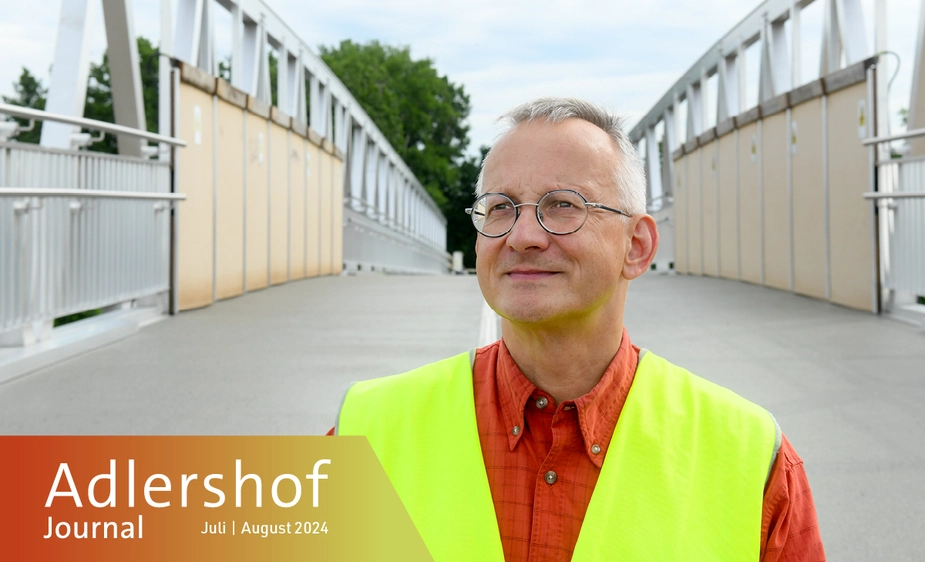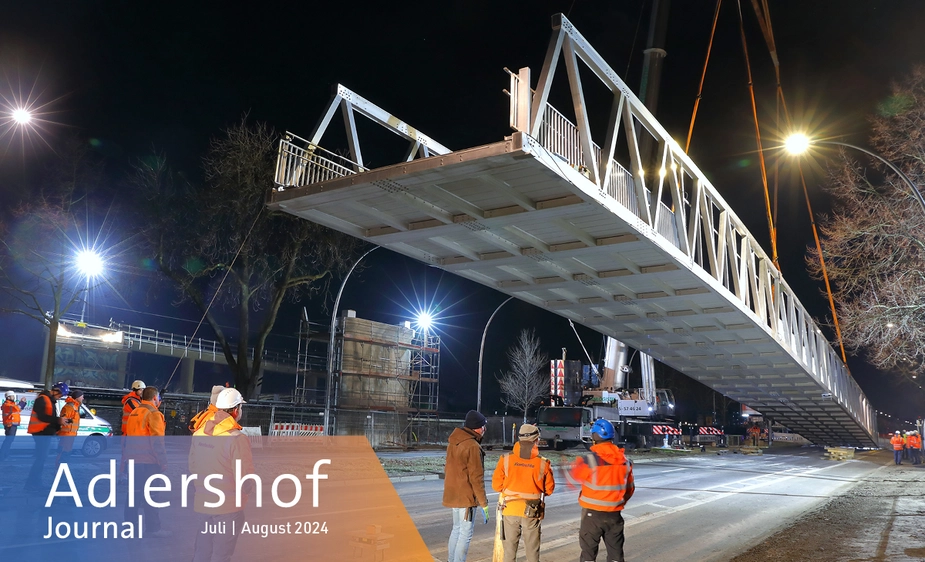Building bridges
Crossing Adergestell on foot or by bike
27 January 2024. Adlershof is fast asleep when, a few minutes before 4 am, a giant crane lifts a delicate structure up from Adlergestell, the main street cutting through Adlershof. The structure hanging from the hook is a good 74 metres long. The bridge will soon cross over the federal highway and the railway line and bring a story to a close that began a good 16 years before.
“It all started with the development plan no 9-60,” says Steffen Kotscha of WISTA.Plan GmbH, who is in charge of the project. “Under this number, the State of Berlin, Deutsche Bahn AG, and the district administration laid out a plan to design the former freight station in Schöneweide.” This was in 2008 and already featured a foot and cycle path back then. As a compensatory measure. “When an area like the former freight station in Schöneweide is redeveloped, many factors must be taken into account, including flora, fauna, climate, air, and transportation,” says the civil engineer. The old railway station premises turned into a small wilderness during the 20 years since reunification. Intervening in nature necessitates striking a balance. Balance can be maintained not only by planting new trees but also through better infrastructure. This includes a foot and cycle bridge. “It’s main function is to overcome the division caused by Adlergestell, which is a federal highway and includes a four-track railway line. However, the bridge is more than just a connection between two sides of a motorway. It also connects the Berlin Wall Trail and the Spree Cycle Route. Additionally, it will be integrated into the Teltow Village Walk, one of 20 green hiking trails in Berlin. Moreover, the bridge creates a secure pathway for the children learning at one of two new schools that are being built in Adlershof’s Science City.
The silver giant is only one part of the bridge. Upstream supports, trough structures, pillars—they all have to be built from scratch. To do so, the teams involved worked not on one but on two construction sites at the same time. “We call the Technology Park side the starting point,” says Kotscha. “The landing point is behind Adlergestell on the other side.” To get from one construction site to the other, you had to drive to Adlershof S-Bahn station, go underneath the bridge, and drive back.
This will be over soon. A moment that everyone has been working towards is now near. It’s Monday, 22 January 2024. Two special trucks have just set off in south Germany. Each of them shoulders one part of the bridge, five-and-a-half metres wide and a good thirty metres long. They can only drive on motorways, because no country road is built for them, and move only at night. It took almost five days to arrive in Berlin. Now the ginormous cargo is sitting on Adlergestell, where the two parts will be assembled into a single bridge. Traffic has been suspended. The federal highway and the railway have been closed. “We had to register this with Deutsche Bahn four years in advance,” says Kotscha. “Year after year we had to report whether we can meet the planned deadline.”
At that moment, nobody is thinking of any of this. All eyes are fixed on the crane lowering the shiny silver components into their final position. Less than two hours later, it’s done. A bridge has been built. The first aluminium bridge of this size in Berlin. This is quite innovative. Usually, this type of bridge is made of concrete or steel. “We meticulously planned the life cycle costs and compared classic construction methods with the more delicate aluminium construction,” explains the civil engineer. “Viewed over the entire lifespan, the latter turned out to be the best option.” The most powerful argument was maintenance costs. Bridges are designed to last a century. During this time, those made of steel must be regularly painted and those made of concrete must be thoroughly inspected. And the aluminium construction? It’s virtually maintenance-free. “Seen from a long-term perspective, higher initial costs are offset by much lower maintenance costs.”
The bridge now is not yet complete. Greenery will be added around it and the surface will be completed before the grand opening in September. Then, finally, the Hilde Archenhold Bridge will fulfil its purpose as a link to Adlershof.
Kai Dürfeld for Adlershof Journal

